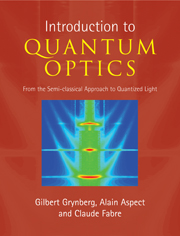Book contents
- Frontmatter
- Contents
- Foreword
- Preface
- Acknowledgements
- Part I Semi-classical description of matterlight interaction
- Part II Quantum description of light and its interaction with matter
- 4 Quantization of free radiation
- Complement 4A: Example of the classical Hamiltonian formalism: charged particle in an electromagnetic field
- Complement 4B: Momentum and angular momentum of radiation
- Complement 4C: Photons in modes other than travelling plane waves
- 5 Free quantum radiation
- Complement 5A: Squeezed states of light: the reduction of quantum fluctuations
- Complement 5B: One-photon wave packet
- Complement 5C: Polarization-entangled photons and violation of Bell's inequalities
- Complement 5D: Entangled two-mode states
- Complement 5E: Quantum information
- 6 Interaction of an atom with the quantized electromagnetic field
- Complement 6A: Hamiltonian formalism for interacting fields and charges
- Complement 6B: Cavity quantum electrodynamics
- Complement 6C: Polarization-entangled photon pairs emitted in an atomic radiative cascade
- Part III Applying both approaches
- Index
Complement 6B: Cavity quantum electrodynamics
Published online by Cambridge University Press: 05 August 2012
- Frontmatter
- Contents
- Foreword
- Preface
- Acknowledgements
- Part I Semi-classical description of matterlight interaction
- Part II Quantum description of light and its interaction with matter
- 4 Quantization of free radiation
- Complement 4A: Example of the classical Hamiltonian formalism: charged particle in an electromagnetic field
- Complement 4B: Momentum and angular momentum of radiation
- Complement 4C: Photons in modes other than travelling plane waves
- 5 Free quantum radiation
- Complement 5A: Squeezed states of light: the reduction of quantum fluctuations
- Complement 5B: One-photon wave packet
- Complement 5C: Polarization-entangled photons and violation of Bell's inequalities
- Complement 5D: Entangled two-mode states
- Complement 5E: Quantum information
- 6 Interaction of an atom with the quantized electromagnetic field
- Complement 6A: Hamiltonian formalism for interacting fields and charges
- Complement 6B: Cavity quantum electrodynamics
- Complement 6C: Polarization-entangled photon pairs emitted in an atomic radiative cascade
- Part III Applying both approaches
- Index
Summary
Up to now in this work we have not been concerned with the environment in which an atom and the radiation field interact. We have implicitly assumed that the radiation propagates in free space and that there are no boundaries to reflect radiation emitted by the atom. We shall show in this complement that when such boundaries do exist and are sufficiently reflecting, or more especially when the atom is enclosed in a resonant cavity, its radiative properties, such as its absorption spectrum and the rate of spontaneous emission, are drastically altered. This can be the case even if the cavity boundaries themselves are very far from the atom, on the atomic scale of distances.
The conditions under which these cavity quantum electrodynamic effects can be observed are actually quite difficult to reach and this is why, usually, it is possible to assume that the radiative properties of a system are independent of the enclosure surrounding it. Nevertheless, thanks to some outstanding technical achievements, these effects can be observed in remarkable experiments. Atoms coupled to cavities then appear as a promising system in quantum information either for quantum processing or for single photon sources (see Complement 5E).
Presentation of the problem
Consider the system sketched in Figure 6B.1, in which an atom at rest at the origin of coordinates is enclosed in a cavity of volume V, with perfectly reflecting walls.
- Type
- Chapter
- Information
- Introduction to Quantum OpticsFrom the Semi-classical Approach to Quantized Light, pp. 502 - 517Publisher: Cambridge University PressPrint publication year: 2010



